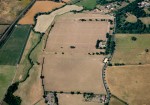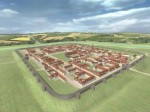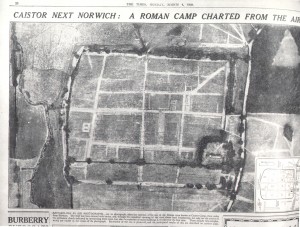 The Norfolk Archaeological Trust (NAT), thanks to grants from National Heritage, English Heritage and the South Norfolk Council, has purchased the rolling green farmland above the archaeological site of Venta Icenorum, an ancient Roman town outside the modern Norfolk village of Caistor St. Edmund. NAT already has 120 acres of the area under conservation, but the west side of the Roman town was under immediate danger from intense agriculture and unauthorised metal detecting. The purchase of the remaining 55 acres means the whole ancient town is now in public hands.
The Norfolk Archaeological Trust (NAT), thanks to grants from National Heritage, English Heritage and the South Norfolk Council, has purchased the rolling green farmland above the archaeological site of Venta Icenorum, an ancient Roman town outside the modern Norfolk village of Caistor St. Edmund. NAT already has 120 acres of the area under conservation, but the west side of the Roman town was under immediate danger from intense agriculture and unauthorised metal detecting. The purchase of the remaining 55 acres means the whole ancient town is now in public hands.
Only a few banks and fragments of stone walls remain above ground, but beneath the earth there are extensive remains of the Roman town where the mutinous Iceni eventually settled down to live in regularly planned houses and streets.
The crop marks also reveal the end of the straight Roman road from Colchester – so they could march straight up to crush any further stirrings of insurrection. […]
The land has now been bought with grants of £374,000 from the National Heritage Memorial Fund – a fund of last resort, which is administered by the Heritage Lottery Fund, but can move faster when a case is seen as urgent – along with £40,000 from English Heritage and £20,000 from South Norfolk council, and money raised by the Norfolk Archaeological Trust, a rare move to bring an archaeology site into public ownership, and the first time the NHMF has bought a site purely for its archaeological value.
 Venta Icenorum, meaning “market town of the Iceni,” is a site of rare historical significance. It is though to have been the capital of the Iceni tribe, the tribe that famously revolted against Roman occupation under warrior queen Boudica in 60-61 A.D. A planned Roman town is built on top of earlier Iceni and Iron Age remains. The Roman town built on both sides of the river Tas was an important one politically as it was the capital of Norfolk and Suffolk. Archaeologically it is invaluable because of it is one of only three remaining buried sites in Britain (the other two are Silchester in Hampshire and Wroxeter Roman City in Shropshire) that were never built on by successive settlements.
Venta Icenorum, meaning “market town of the Iceni,” is a site of rare historical significance. It is though to have been the capital of the Iceni tribe, the tribe that famously revolted against Roman occupation under warrior queen Boudica in 60-61 A.D. A planned Roman town is built on top of earlier Iceni and Iron Age remains. The Roman town built on both sides of the river Tas was an important one politically as it was the capital of Norfolk and Suffolk. Archaeologically it is invaluable because of it is one of only three remaining buried sites in Britain (the other two are Silchester in Hampshire and Wroxeter Roman City in Shropshire) that were never built on by successive settlements.
This is the only one of the three which was also inhabited by Anglo-Saxons after the collapse of Roman control. There is evidence that Venta Icenorum was used by Anglo-Saxons as a market town until it was eventually abandoned in favor of burgeoning Norwich some time after the 5th century. Venta was left to overgrow and provide grazing ground for sheep.
The site is an archaeological gold mine, in other words, a rare opportunity to study the lives of pre-Roman, Roman and Anglo-Saxon Britain and the transitional periods between them without have to deal with medieval through modern habitation and reconstruction. The west and east sides of the town will be reconnected and the entire site will be an open-air archaeological museum open to the public.
 The extent of the remains of Venta Icenorum were first realized on July 20, 1928, by the crew of a RAF airplane photographing the area from the sky. That summer was exceptionally dry and the barley that had been planted over the hard structures ripened early, leaving the street plan of the Roman town clearly outlined by the parched white grain. For the first time building like a pair of twin temples in the center. The pictures were published in The Times a year later and the first archaeological excavation of the site followed shortly thereafter.
The extent of the remains of Venta Icenorum were first realized on July 20, 1928, by the crew of a RAF airplane photographing the area from the sky. That summer was exceptionally dry and the barley that had been planted over the hard structures ripened early, leaving the street plan of the Roman town clearly outlined by the parched white grain. For the first time building like a pair of twin temples in the center. The pictures were published in The Times a year later and the first archaeological excavation of the site followed shortly thereafter.